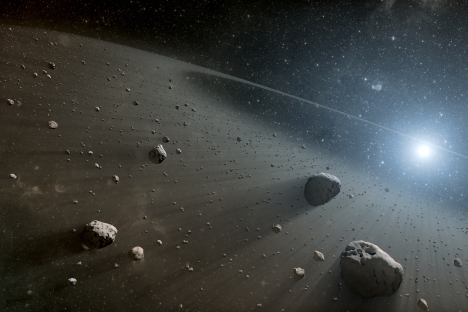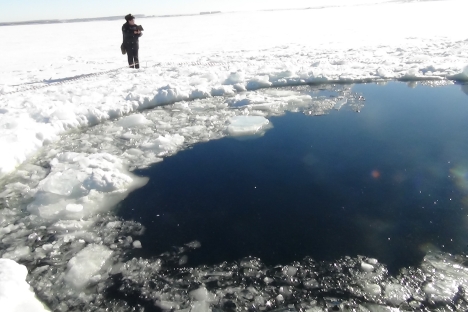
The number of potentially hazardous cosmic bodies that could collide with Earth in the next 100-200 years is estimated at 200,000-300,000, yet only 2 percent of them are known to astronomers. Source: NASA / Artist's rendering
New rocket launchers and super telescopes will help protect Russia from asteroids and comets, and a new national program to combat extraterrestrial threats could appear in Russia by late 2013. This was the topic of discussion at a roundtable held in Moscow in middle March.
Super telescopes and an asteroid directory
The discussion about asteroids is related to the recent incident in Russia. In mid-February 2013, the Chelyabinsk region was hit by a meteorite. At an altitude of about 15.5 miles above the Earth, the cosmic body exploded and its debris fell to the ground. As a result of the shock wave, more than 1,000 people were hurt and over 7,000 buildings were damaged, causing material harm estimated at more than one billion rubles ($32.4 million).
The chairman of the expert group on cosmic threats at the Space Council of the Russian Academy of Sciences (RAS), Boris Shustov, suggests that, in order to detect dangerous space objects like the Chelyabinsk meteorite, ground- and space-based systems need to be set up. This includes the completion of an ultra-wide-angle telescope at Russia's Lake Baikal.
Director of the Institute of Applied Astronomy, Alexander Ipatov, believes that Russia should improve its system of asteroid monitoring to be able to counter possible threats from outer space, which, first and foremost, requires that all asteroids be catalogued.
"The threats posed by asteroids cannot, of course, be compared with the dangers arising from space debris. Our institute is cataloguing all small bodies in the solar system. But, in terms of observation, Russia is lagging behind. For example, the U.S. has already recorded all asteroids more than one kilometer wide — more than 800,000 celestial bodies in total," he said.

A place where the meteorite fell in mid-February in Russia's Urals. Source: ITAR-TASS
The number of potentially hazardous cosmic bodies that could collide with Earth in the next 100-200 years is estimated at 200,000-300,000, yet only 2 percent of them are known to astronomers.
Director of the Keldysh Institute of Applied Mathematics under the RAS, Boris Chetverushkin, proposes, in turn, the establishment of a national center to process and analyze near-Earth asteroids.
Nuking asteroids
President and chief designer of RSC Energia, Vitaly Lopota, believes that the existing system of rocket launchers should be upgraded to achieve a carrying capacity of 70 tons by 2020 (and 150 tons by 2030), in order to help protect Russia against asteroids and comets.
Russian scientists come up with project to shoot down the Apophis asteroid
Super-heavy launchers are required to propel spacecraft beyond low-Earth orbit, so that they can intercept dangerous asteroids on distant approaches to Earth. As Lopota explains, a super-heavy rocket-launcher would be able to deliver a thermonuclear charge to large asteroids.
However, national and international asteroid-defense systems involving the use of nuclear warheads would require amendments to the Treaty on the Nonproliferation of Nuclear Weapons (NPT) and the nuclear test ban.
In the opinion of Oleg Shubin, a departmental director at Rosatom, non-nuclear ways of deflecting and destroying Earth-bound asteroids may be exotic but ineffective.
Countering the space threat
The head of Roscosmos, Vladimir Popovkin, announced that Russia has three plans: one under RAS to develop optical means (observation), another under Roscosmos to combat cosmic threats, and a third under the Ministry of Defense. “[The plans] need to be combined. A prototype program to combat cosmic threats could appear at the end of 2013," says Popovkin.
According to the Roscosmos head, actual measures to counter a space threat would take at least 5-7 years to put in place.
Near-Earth junk
On the topic of space debris, Popovkin believes that it poses the greatest threat to satellites located in geostationary orbit, warning that the orbit would be completely clogged up within 20 years if the international community did not take urgent measures.
There are currently more than 600,000 pieces of "junk" in low-Earth orbit that are greater than one centimeter in diameter. A collision with such an object can cause serious damage to a satellite, while an object greater than 10 centimeters in diameter (of which there are at least 16,000) can "kill" a spacecraft.
Satellites regularly have to be led away from hazardous debris — a process which uses up valuable fuel and reduces a satellite’s life span. Debris currently costs European satellite operators an estimated €140 million ($181 million) per year, which could rise to €210 million ($271 million) in the next decade.
First published in Russian in RIA Novosti.
All rights reserved by Rossiyskaya Gazeta.
Subscribe
to our newsletter!
Get the week's best stories straight to your inbox